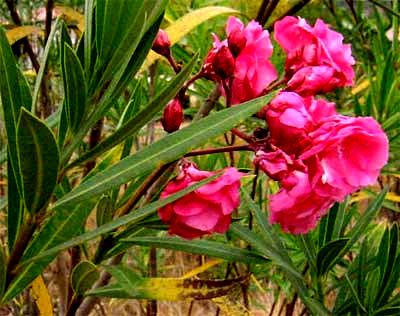Excerpts from Jim Conrad's
Naturalist Newsletter
From Jim Conrad's Naturalist Newsletter of February 25, 2008 Newsletter written in the community of 28 de Junio, in the Central Valley 8 kms west of Pujiltic, elev. ~700m (2300ft), ~N16.331°, ~W92.472°; southeastern Chiapas state, MÉXICO
OLEANDERS FLOWERING

Above you see the oleanders, NERIUM OLEANDER, flowering outside my door these days. When I read what my little Golden Nature Guide Exotic Plants has to say about the species I'm not surprised that it refers to oleanders as "the most popular ornamental of all warm areas."
Nothing is more typical here in Mexico than for a town's streets and parks to be planted with thousands of white-, pink- and red-flowering oleander varieties. Oleanders are even favored in such semitropical and non-tropical places as California, deep Texas, and on coastal islands of the US Carolinas, where their salt tolerance also is appreciated. The only thing detracting from the oleander's excellence as an ornamental shrub is that all parts of the plant are highly poisonous.
It's hard to interpret flower anatomy on the plants outside my door because they're double-flowered horticultural monstrosities, as I suppose most garden oleanders are nowadays. In double-flowered varieties, typically the plant breeder has caused stamens or other flower parts to abnormally develop into colorful petals, in much the same way that sometimes on a chicken's leg feathers arise where scales should be.
Wild oleanders in their Mediterranean homeland bear flowers with funnel-shaped corollas, and each flower's throat is set with five frilly teeth. They're neat, elegant blossoms with each flower-part reflecting the wisdom of eons of evolution and answering to particular needs of specific local pollinators.
But flowers on the bushes outside my door answer to nothing but the human appetite for ever-larger splashes of gaudiness everywhere all the time. My double-flowered oleanders look uncannily like double-flowered begonias, double-flowered camellias, double- flowered buttercups, double-flowered roses, and all the other double-flowered varieties they've come up with.